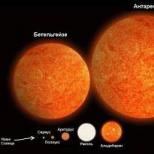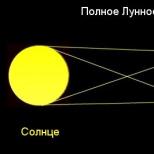What physical phenomenon is responsible for the Tyndall effect? Scattering of light. Rayleigh's law. Tyndall effect. Molecular scattering. Nephelometry. Applying the Tyndall effect
In terms of optical properties, colloidal solutions differ significantly from true solutions of low molecular weight substances, as well as from coarsely dispersed systems. The most characteristic optical properties of colloid-dispersed systems are opalescence, the Faraday-Tyndall effect, and color. All these phenomena are due to the scattering and absorption of light by colloidal particles.
Depending on the wavelength of visible light and the relative sizes of the particles of the dispersed phase, the scattering of light takes on a different character. If the particle size exceeds the wavelength of light, then light is reflected from them according to the laws of geometric optics. In this case, part of the light radiation can penetrate inside the particles, experience refraction, internal reflection, and be absorbed.
If the particle size is smaller than the half-wavelength of the incident light, diffractive light scattering is observed; the light, as it were, bypasses (envelops) the particles encountered on the way. In this case, partial scattering takes place in the form of waves diverging in all directions. As a result of the scattering of light, each particle is a source of new, less intense waves, i.e., it is as if self-luminescence of each particle occurs. The phenomenon of light scattering by tiny particles is called opalescence. It is characteristic mainly of sols (liquid and solid), it is observed only in reflected light, i.e., from the side or against a dark background. This phenomenon is expressed in the appearance of some turbidity of the sol and in the change (“overflows”) of its color compared to the color in transmitted light. Coloring in reflected light, as a rule, is shifted towards the higher frequency of the visible part of the spectrum. So, white sols (silver chloride sol, rosin, etc.) opalescent with a bluish color.
Faraday-Tyndall effect. Diffraction scattering of light was first noticed by M. V. Lomonosov. Later, in 1857, this phenomenon was observed by Faraday in gold sols. The phenomenon of diffraction (opalescence) for liquid and gaseous media was studied in most detail by Tyndall (1868).
If you take one glass with a solution of sodium chloride, and the other with an egg white hydrosol, it is difficult to establish where the colloidal solution is and where the true one is, since both liquids look colorless and transparent (Fig. 6.5). However, these solutions can be easily distinguished by doing the following experiment. Let's put on a light source (table lamp) an opaque case with a hole, in front of which, in order to obtain a narrower and brighter beam of light, we put a lens. If both glasses are placed in the path of the light beam, we will see a light path (cone) in the glass with the sol, while the beam is almost invisible in the glass with sodium chloride. By the name of the scientists who first observed this phenomenon, a luminous cone in a liquid was called the Faraday-Tyndall cone (or effect). This effect is characteristic of all colloidal solutions.
The appearance of the Faraday-Tyndall cone is explained by the phenomenon of light scattering by colloidal particles with a size of 0.1-0.001 microns.
The wavelength of the visible part of the spectrum is 0.76-0.38 microns, so each colloidal particle scatters the light falling on it. It is visible in the Faraday-Tyndall cone when the line of sight is directed at an angle to the beam passing through the sol. Thus, the Faraday-Tyndall effect is a phenomenon identical to opalescence, and differs from the latter only in the form of a colloidal state, i.e., the microheterogeneity of the system.
The theory of light scattering by colloidal dispersed systems was developed by Rayleigh in 1871. It establishes the dependence of the intensity (amount of energy) of scattered light (I) during opalescence and in the Faraday-Tyndall cone on external and internal factors. Mathematically, this dependence is expressed in the form of a formula called the Rayleigh formula:
| | 6.1 |
where I is the scattered light intensity in the direction perpendicular to the incident light beam; K is a constant depending on the refractive indices of the dispersion medium and the dispersed phase; n is the number of particles per unit volume of the sol; λ is the wavelength of the incident light; V is the volume of each particle.
From formula (6.1) it follows that the scattering of light (I) is proportional to the concentration of particles, the square of the volume of the particle (or for spherical particles - the sixth power of their radius) and inversely proportional to the fourth power of the wavelength of the incident light. Thus, the scattering of short waves occurs relatively more intensively. Therefore, colorless sols appear reddish in transmitted light, and blue in diffused light.
Coloring of colloidal solutions. As a result of the selective absorption of light (absorption) in combination with diffraction, one or another color of the colloidal solution is formed. Experience shows that most colloidal (especially metallic) solutions are brightly colored in a wide variety of colors, ranging from white to completely black, with all shades of the color spectrum. So, As 2 S 3 sols are bright yellow, Sb 2 S 3 - orange, Fe (OH) 3 - reddish brown, gold - bright red, etc.
The same sol has a different color depending on whether it is viewed in transmitted or reflected light. Sols of the same substance, depending on the method of preparation, can acquire a different color - the phenomenon of polychromy (multicolor). The color of the sols in this case depends on the degree of dispersion of the particles. Thus, coarsely dispersed gold sols have a blue color, a greater degree of dispersion - violet, and highly dispersed - bright red. It is interesting to note that the color of the metal in the non-dispersed state has nothing to do with its color in the colloidal state.
It should be noted that the color intensity of sols is tens (or even hundreds) times greater than that of molecular solutions. Thus, the yellow color of the As 2 S 3 sol in a layer 1 cm thick is clearly visible at a mass concentration of 10 -3 g/l, and the red color of the gold sol is noticeable even at a concentration of 10 -5 g/l.
The beautiful and bright color of many precious and semiprecious stones (rubies, emeralds, topazes, sapphires) is due to their content of negligible (not detectable even on the best analytical balance) amounts of impurities of heavy metals and their oxides, which are in a colloidal state. So, to artificially obtain bright ruby glass used for automobile, bicycle and other lamps, it is enough to add only 0.1 kg of colloidal gold per 1000 kg of glass mass.
One glass with sodium chloride solution, and the other with egg white hydrosol, it is difficult to establish where the colloidal solution is, and where is the true one, since both liquids look colorless and transparent (Fig. 85). However, these solutions can be easily distinguished by doing the following experiment. Let's put on (a table lamp) an opaque case with a hole in front of which, in order to obtain a narrower and brighter beam of light, we put a lens. If both glasses are placed in the path of the light beam, we will see a light path (cone) in the glass with the sol, while the beam is almost invisible in the glass with sodium chloride. By the name of the scientists who first observed this phenomenon, a luminous cone in a liquid was called the Faraday-Tyndall cone (or effect). This effect is characteristic of all colloidal solutions.
Thus, the Faraday-Tyndall effect is a phenomenon identical to opalescence, and differs from the latter only in the form of a colloidal state, i.e., the microheterogeneity of the system.
In HMS solutions, the Faraday-Tyndall effect is not very clearly detected due to the fact that the refractive index of the solvated particles of the solute n differs little from the refractive index of the solvent Po, therefore the difference n - o-O, and the intensity of light scattering by HMS solutions is insignificant (see Chap. VII, 91). For the same reason, macromolecules cannot be detected under an ultramicroscope.
All the optical properties of highly dispersed systems, from which we will consider here coloration, opalescence, the Faraday-Tyndall effect and phenomena observed with an ultramicroscope, are interesting primarily because, as Fig. 2, their intensity is maximum in the colloidal region of dispersity . This feature is due to the fact that the wavelength of light waves in the visible part of the spectrum (760-400 mm) exceeds the particle size of highly dispersed systems (200-2 mm). The intensity of expression of these properties with the value of the difference in the densities of the substances of the dispersed phase d and the dispersion medium o and with the difference in their refractive indices n and n. the more differences d-i p-p, the more pronounced are the optical properties. This explains the fact that the optical properties are generally incomparably more pronounced in sols (especially metallic ones) than in solutions of macromolecular compounds. For this reason, our further description of optical properties will deal almost exclusively with sols.
OPALECENCE AND THE FARADEY-TYNDAL EFFECT
It was found that when passing a beam of light through pure water and other pure liquids and through pure (i.e., devoid of droplets and crystals of water and dust) air, and solutions with a low molecular weight solute, the Faraday-Tyndall effect is not observed, as it is not observed in them and opalescence. Such media are called optically empty. Consequently, the Faraday-Tyndall effect was an important tool for detecting the colloidal state, i.e., the microheterogeneity of the system.
The phenomenon of light scattering by the smallest particles lies in
Tyndall Effect Tyndall effect (Tyndall scattering) Scattering of light when a light beam passes through an optically inhomogeneous medium. It is usually observed as a luminous cone (Tyndall's cone) visible against a dark background. Typical for... Explanatory English-Russian dictionary on nanotechnology. - M.
Tyndall effect- Tindalio reiškinys statusas T sritis fizika atitikmenys: engl. Faraday Tyndall effect; Tyndall effect vok. Faraday Tyndall Effect, m; Tyndall Effect, m rus. Tyndall effect, m; Faraday Tyndall phenomenon, n pranc. effet Faraday Tyndall, m; effet… … Fizikos terminų žodynas
Tyndall effect- see Tyndall's cone ... Chemical terms
TYNDAL PHENOMENON- TYNDAL PHENOMENON, phenomenon, or effect, consists in the fact that a bright beam of light passing through some transparent bodies and viewed in a direction perpendicular to the course of light rays is visible in the corresponding transparent body as some kind of region ... ... Big Medical Encyclopedia
Raman scattering of light (Raman effect) is the inelastic scattering of optical radiation on the molecules of a substance (solid, liquid or gaseous), accompanied by a noticeable change in its frequency. Unlike Rayleigh scattering, in the case of ... ... Wikipedia
Appearance of a luminous cone on a darker background (Tyndall's cone) upon scattering of light with a wavelength K in a turbid medium with dimensions h » 0.1l. Named after the English physicist J. Tyndall, who discovered the effect; characteristic of colloidal ... ... Physical Encyclopedia
Scattering of light in turbid media with sizes of scattering inhomogeneities? 0.1 0.2 wavelengths of light. The scattered beam of light, when viewed from the side, has the form of a bluish cone on a dark background (Tyndall's cone). Studied by J. Tyndall (1868). On the… … Big Encyclopedic Dictionary
Tyndall scattering, Scattering of light during the passage of a light beam through an optically inhomogeneous medium. It is usually observed as a luminous cone (Tyndall's cone) visible against a dark background. Characteristic for solutions of colloidal systems (See ... ... Great Soviet Encyclopedia
Scattering of light in turbid media with sizes of scattering inhomogeneities Tyndall effect 0.1 0.2 wavelengths of light. The scattered beam of light, when viewed from the side, has the form of a bluish cone on a dark background (Tyndall's cone). Studied by J. Tyndall ... ... encyclopedic Dictionary
Scattering of light in turbid media with dimensions of scattering inhomogeneities of 0.1 0.2 wavelengths of light. The scattered beam of light, when viewed from the side, has the form of a bluish cone on a dark background (Tyndall's cone). Studied by J. Tyndall (1868). On T. e ... Natural science. encyclopedic Dictionary
Lesson objectives:
Educational: to acquaint students with the optical properties of colloidal solutions.
Developing: expand students' understanding of the optical properties of colloidal solutions. develop them cognitive activity and the ability to highlight the main thing in visual information.
Nurturing: continue to cultivate attentiveness, observation, aesthetic feelings, the ability to handle technology.
Visual aids: computer, screen, projector.
Technology: lecture using TCO (computer technology).
Stages of the lesson: I Organizational part
Light scattering in colloidal solutions. Tyndall-Faraday effect
The optical properties of colloidal solutions are determined by light scattering in colloidal solutions, the color of colloidal solutions, the absorption of light by colloids, the reflection of light by the particle surface, as well as ultramicroscopic, electron microscopic and X-ray properties. Very often colloidal systems are colored. The color changes depending on the degree of dispersion, the chemical nature of the particles and their shape, since these factors affect the scattering and adsorption of light. Sols of metals having a high degree dispersion, usually have a red or dark yellow color, and metals with a low degree of dispersion are purple or pale blue. For example, with a higher degree of fineness, gold sols acquire a red color, and with a low degree, violet and pale blue. The color of metal sols also depends on the length of the absorbed light wave. Searchlight beam, fog, smoke are colorless. The blue color of the sky is due to the light scattering of sunlight in the layers of air.
If the particle size is greater than the wavelength of light, then, according to the law of geometric optics, light is reflected from the surface of the particle. However, if the particles are smaller than the wavelength of light, then among the observed optical phenomena, light scattering takes place. Therefore, when light passes through colloid-dispersed and coarsely dispersed systems, light is scattered by particles of the dispersed phase. If you direct a beam of a light beam at a dispersed system, its path is visible when viewed from the side in the form of a luminous cone. This phenomenon was studied first by Faraday, and then in more detail by Tyndall. Therefore, this phenomenon is called the Tyndall-Faraday effect.
To observe the Tyndall-Faraday effect, the dispersed system (C) is poured into a tetrahedral glass container (cuvette), a dark curtain is placed in front of the cuvette and illuminated with a projection lamp (A) (Fig. 8). In this experiment, a luminous cone is formed, the cause of which is the scattering of light by colloidal particles, and as a result, each particle seems to be a point that gives light. The process of light scattering by tiny particles is called opalescence. In true aqueous solutions, in a mixture of pure liquids, light is scattered in negligible amounts and therefore the Tyndall-Faraday effect is not observed. It can be seen only in a special device. Sometimes outwardly it is not possible to distinguish a true solution from a colloidal one, and to establish whether a given solution is a colloid or a true solution, the Tyndall-Faraday effect is used. The intensity of the Tyndall-Faraday effect increases with an increase in the degree of dispersion of the sol, and when a certain degree of dispersion is reached, it reaches a maximum and then decreases. In coarsely dispersed systems (due to the fact that the particle size is greater than the wavelength of light), light is reflected from the surface of the particle at a certain angle, and as a result, light reflection is observed.
Coarsely dispersed systems equally reflect light waves different lengths. If the system falls White light, then the reflected light will also be white.
The process of scattering of light waves by colloidal particles depends on the length of the light wave. According to the Rayleigh law, the intensity of light scattering in a colloidal system, due to diffraction, is proportional to the number of particles, the square of the particle volume, and is inversely proportional to the fourth power of the wavelength of the incident light.

Here J0? scattered light intensity, J? incident light intensity, v- numerical concentration, V? particle volume, n1- refractive index of the dispersed phase, n2? refractive index of the dispersion medium, k is a constant depending on the intensity of the incident light and on the difference between the refractive indices of the dispersed phase and the dispersion medium, l- length of light wave, nm.
Meaning n1 in this equation depends on the nature of the substance. If n1 And n2 are equal to each other, then in such systems the Tyndall-Faraday effect is not observed. The greater the difference between the refractive indices of the dispersed phase and the dispersion medium, the more clearly the Tyndall-Faraday effect is observed.
The Rayleigh equation is applicable only for such colloidal solutions in which the particle size is not more than 0.1 wavelength of light. It can be seen from the equation that the intensity of light scattering is inversely proportional to the fourth power of the wavelength and therefore shorter waves are formed during the scattering process. Therefore, when lateral illumination of a colloidal solution with polychromatic (white) light, colloidal solutions have a bluish color.
Scattering of light. From the classical point of view, the scattering of light is that
Electromagnetic waves passing through matter cause oscillations of electrons in atoms. Explanation: if the particle size is small, then the electrons that make
forced vibrations in atoms are equivalent to an oscillating dipole. This dipole oscillates with the frequency of the light wave incident on it. Hence, the short-wavelength part of the spectrum is scattered much more intensively than the long-wavelength part. Blue light scatters almost 5 times more intensely than red. Therefore, scattered light is blue, and transmitted light is reddish. At very high altitudes (hundreds of kilometers), the concentration of atmospheric molecules is very low, scattering practically disappears, the sky should appear black, and stars are visible in the presence of the Sun. At space flights All these predictions were completely confirmed.
The Rayleigh-Jeans law is the law of radiation for the equilibrium radiation density of a blackbody and for the emissivity of a blackbody.
Tyndall effect, Tyndall scattering (eng. Tyndall effect) - an optical effect, light scattering when a light beam passes through an optically inhomogeneous medium. It is usually observed as a luminous cone (Tyndall's cone) visible against a dark background.
It is typical for solutions of colloidal systems (for example, sols, metals, diluted latexes, tobacco smoke), in which particles and their environment differ in refractive index.
Nephelometry is a method of research and analysis of a substance by the intensity of the light flux scattered by suspended particles of a given substance.
The essence of the method
The intensity of the scattered light flux depends on many factors, in particular, on the concentration of particles in the analyzed sample. Great importance in nephelometry, it has the volume of particles that scatter light. An important requirement for reactions used in nephelometry is that the reaction product must be practically insoluble and be a suspension (suspension). To hold solid particles in suspension, various stabilizers (eg gelatin) are used to prevent particle coagulation.
50. Thermal radiation of bodies. Laws of black body radiation (Stefan-Boltzmann, Wien).
Between all bodies of nature there is an endless process of energy exchange. Bodies continuously emit and absorb energy. If the excitation of atoms occurs as a result of their collision with other atoms of the same body in the process of thermal motion, then the resulting electromagnetic radiation is called thermal.
Thermal radiation occurs at any temperature. In this case, regardless of temperature, the body emits all wavelengths without exception, i.e. range thermal radiation is continuous and extends from zero to infinity. However, the higher the temperature, the more short-wave radiation is the main one in the radiation spectrum. The process of emission of electromagnetic waves by the body occurs simultaneously and independently with their absorption.
A body that completely absorbs energy in the entire wavelength range, i.e. for which α = 1 is called absolutely black (black)
STEFAN-BOLTZMANN LAW. Wien's displacement law
Stefan and Boltzmann obtained an integral expression for the energy luminosity of a black body, which does not take into account the distribution of energy over wavelengths:
R \u003d σT 4, σ is the Stefan-Boltzmann constant (σ \u003d 5.6696 10 -8 W / (m 2 K 4)).
For gray bodies Kirchhoff's law allows us to write r λ = α λ ε λ , then for the energy luminosity of gray bodies we have: .
Analyzing the curves, Win found that the wavelength, which accounts for the maximum spectral density of energy luminosity, is determined by the relationship: .
This is Wien's law, where b = 0.28978·10 -2 m·K is Wien's constant.
Let us determine the value of the wavelength for which ε λ has a maximum value at a given temperature, based on the ratio. According to the rules for finding extrema, this will be subject to . Calculations show that this will take place if λ = b/T.
It can be seen from the relationship that with increasing temperature, the wavelength, which accounts for the maximum emissivity of a completely black body, shifts to the short-wavelength region. For this reason, the ratio is known in scientific literature also as Wien's displacement law. This law is also valid for gray bodies.
The Stefan-Boltzmann and Wien laws make it possible to determine their temperatures based on measurements of the energy radiated by a body. This branch of physics is called optical pyrometry.





